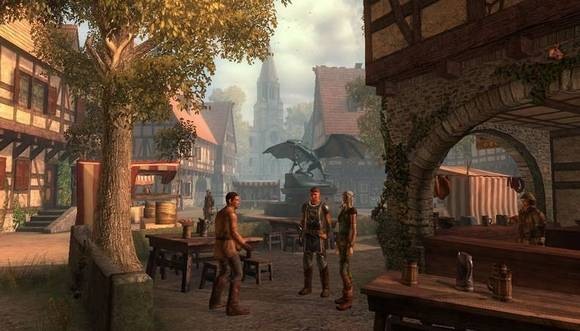As a follow-up to my post on Virtual Worlds the other day, here’s a post on Drakensang – after spending about six evenings in it, several of which with Hannah cradled in my arms.
Visually, the game’s amazing, the more so considering that the game wasn’t from some big California-based game studio. I ran the game on my two year old game rig and it ran very well on the 1680×1050 resolution my screen can handle – with all graphic options enabled. There’s also a High Quality Texture pack option, but I don’t think even that is going to stretch modern machines much.
The artwork itself is marvelous: there’re sunny plains, dark forests with little light escaping from the overhead canopy of trees, snow covered landscapes, caves, mines, a huge Dwarvern underground city, and suitably medieval-looking towns, villages and cities.
The game has a main quest storyline, supplemented with numerous other side quests, several of which are nicely tied in with the main story through dialog. The quests themselves span quite a wide range: you have the medieval courier pigeon types (“Fetch this”) and roach infestation and cleaning operation (“Kill all the bugs in the storage warehouse”) type. But you also have quests that require you to do other things: including be stealthy, or to play detective in solving a crime.
For those of us who love building up unique characters, Drakensang is nirvana. Character growth is facilitated by two types of point systems: Adventure Points, which continually accumulate and serves as a broad indicator of your character prowess, and Experience Points, which you expend to improve a skill, talent or attribute. The game nicely balances the number of growth points versus the range in which you can develop your party characters – i.e. there aren’t nearly enough points to create Godlike characters who can do everything.

That said, Drakensang drops the ball in a couple of departments. The most significant one is the game’s difficulty level. There are no difficulty sliders in the game, and the game is very hard. The quests themselves are alright, thanks in part to the helpful in-game hint system that provides tips in the Quest Log, and also highlighting of “Next Place to Visit” on the overview map. Rather, it’s the combat system that’ll have you reaching for the Quick Save and Load buttons repeatedly. Party wipes are very common, and mobs typically make a beeline for your weakest characters first in a fight.
There’s also a lot of dialog in the game, which while are reasonably well-translated from the German source, could also be just a little too much for players to digest. In a typical conversation with an NPC, expect to be clicking 8 to 10 times to progress from conversation paragraph to paragraph before you even get to the first dialog option. The recorded audio and exaggerated character animation during conversations have also been panned by game critics, but I personally didn’t find them any more cringe-inducing than the voice-acting in typical games of this type.
And there’s the funny path finding in tight corridors or rooms. Oh, your party of characters follow you well-enough. But when you tell the entire party to fight the same mob, the path finding will run amok with your characters running circles around each other as though it can’t decide where it wants to position each party member. It’s a cute sight though, watching your party of four chase each other’s coat tails in a room.
All that said, I enjoyed Drakensang. The story isn’t anything you haven’t already seen or experienced in other RPGs, but one has to compensate considering that there just aren’t very many traditional RPGs out there. There’s character c
Recent comments